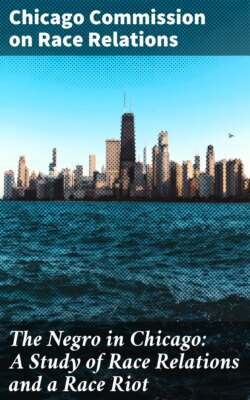Читать книгу The Negro in Chicago: A Study of Race Relations and a Race Riot - Chicago Commission on Race Relations - Страница 27
IV. THE ARRIVAL IN CHICAGO
ОглавлениеAt the time of the migration the great majority of Negroes in Chicago lived in a limited area on the South Side, principally between Twenty-second and Thirty-ninth streets, Wentworth Avenue and State Street, and in scattered groups to Cottage Grove Avenue on the east. State Street was the main thoroughfare. Prior to the influx of southern Negroes, many houses stood vacant in the section west of State Street, from which Negroes had moved when better houses became available east of State Street. Into these old and frequently almost uninhabitable houses the first newcomers moved. Because of its proximity to the old vice area this district had an added undesirability for old Chicagoans. The newcomers, however, were unacquainted with its reputation and had no hesitancy about moving in until better homes could be secured. As the number of arrivals increased, a scarcity of houses followed, creating a problem of acute congestion.
During the summer of 1917 the Chicago Urban League made a canvass of real estate dealers supplying houses for Negroes, and found that in a single day there were 664 Negro applicants for houses, and only fifty houses available. In some instances as many as ten persons were listed for a single house. This condition did not continue long. There were counted thirty-six new neighborhoods, formerly white, opening up to Negroes within three months.
At the same time rents increased from 5 to 30 and sometimes as much as 50 per cent. A more detailed study of living conditions among the early migrants in Chicago was made by the Chicago School of Civics and Philanthropy. The inquiry included seventy-five families of less than a year's residence. In the group were sixty married couples, 128 children, eight women, nine married men with families in the South. Of these migrants forty-five families came from rural and thirty-two from urban localities. The greatest number, twenty-nine, came from Alabama; twenty-five were from Mississippi, eleven from Louisiana, five from Georgia, four from Arkansas, two from Tennessee, and one from Florida. Forty-one of these seventy-five families were each living in one room. These rooms were rented by the week, thus making possible an easy change of home at the first opportunity.
It was at this period that the greatest excitement over the "incoming hordes of Negroes" prevailed.
A significant feature was the large number of young children found. The age distribution of 128 children in these seventy-five families was forty-seven under seven years, forty-one between seven and fourteen years, and forty over fourteen years.
Most of these children were of school age and had come from districts in the South which provided few school facilities. The parents were unaccustomed to the requirements of northern schools in matters of discipline, attendance, and scholarship. Considerable difficulty was experienced by teachers, parents, and children in these first stages of adjustment.
